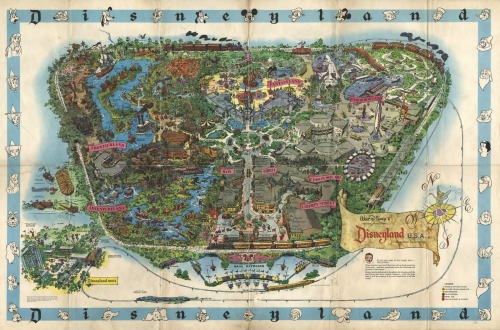 It’s well known that Walt Disney had large format, elegant maps made as part of the proposals to secure investment for the creation of Disneyland in California in the early 1950s. The perspective views of the imaginary land he envisaged, drawn by Herbert Ryman, were crucial to securing the finances he needed for the project. Another iconic map, by Peter Ellenshaw was featured on early souvenir postcards and brochures of the park. Ellenshaw was an acclaimed artist and visual effects pioneer who worked on many of Disney’s films and is credited with the first official map of Disneyland.
It’s well known that Walt Disney had large format, elegant maps made as part of the proposals to secure investment for the creation of Disneyland in California in the early 1950s. The perspective views of the imaginary land he envisaged, drawn by Herbert Ryman, were crucial to securing the finances he needed for the project. Another iconic map, by Peter Ellenshaw was featured on early souvenir postcards and brochures of the park. Ellenshaw was an acclaimed artist and visual effects pioneer who worked on many of Disney’s films and is credited with the first official map of Disneyland.
Disneyland opened in 1955 but an early oversight, or lack of time and funds, meant that the first souvenir map proper wasn’t available to purchase until 1958. Neither the Ryman or Ellenshaw maps were to be used. Instead, Disney artist and Imagineer Sam McKim became the master of Disney’s theme park maps. Actor turned artist McKim’s drawings inspired many of Disney’s films and theme park attractions but it is his early, intricate and fascinating theme park souvenir maps for which he is renowned. The maps are rich in detail, contain perfectly positioned drawings amongst the landscape and the text and labels sits effortlessly in the design. There are characters, animals and motion depicted throughout (e.g. running or flowing water) to give a sense of a living, breathing, exciting place.
What better way to remember your time in the ‘happiest place on earth’ than by taking home a map and pinning it to your wall. The detailed pictorial style of McKim’s map matched the enchantment of the park itself, allowing one to relive a visit and also think out and plan the next. The map’s detail is labyrinthine and encouraged deep exploration to uncover all of the pieces in the park which, quite simply, was impossible during a single visit to the park itself. The map, then, became an intrinsic part of the experience and even though the park was an imagined environment, the presence of such a map brought a sense of realism and permanence. Even when you are not in the park, you can pour over the map and experience it all over again. The ability of McKim to convey the sense of wonder that Disney wanted the park to evoke is a classic piece of cartographic story-telling.
Souvenir maps became a priority in 1957 and McKim was tasked with creating the map. The first edition, measuring 30″ by 45″ was sold during 1958 in a rolled up tube but subsequently, the maps were folded in twelfths measuring 8″ by 15″ to allow them to be sold more readily. McKim was responsible for revisions for two more editions of the map in 1958 and 1959 to add various new attractions as the park grew rapidly and four more of his maps were produced until 1964. They can be identified by the coloured border with the blue one shown here being the 1962 version. All followed the beautiful illustrative form of the original.
McKim even managed to make a small appearance in the map himself as he hid his initials (SM) in amongst the trees and bushes next to the covered bridge (above). Many cartographers include small hidden visual treats. McKim’s original maps are now much sought after collectibles for their quality and beauty. McKim was also responsible for drawing the map for the celebrated opening of Euro Disneyland in Paris in a style similar to his original maps.
McKim’s work lay the groundwork for theme park mapping globally. His style and approach has been used by countless other artists for many other parks. If the true measure of cartographic greatness is imitation then McKim’s work stands tall. He has been recognised with his own window on Main Street in Disneyland as which states “Cartography Masterworks – Sam McKim – Map Maker of the Kingdom – There’s Magic in the Details.” Attention to detail is more often than not what makes great cartography. McKim’s maps certainly captured the detail of the park, the imaginary world it represented and portrayed it in a captivating style.
Discover more about McKim’s work and the multitude of maps of Disneyland here.



